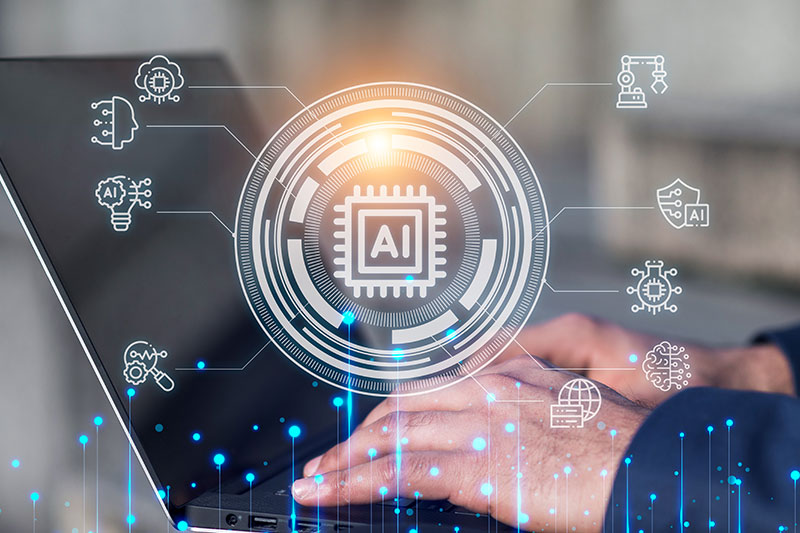In his groundbreaking presentation at the TED AI conference, OpenAI’s Noam Brown revealed a revolutionary and jaw-dropping concept: 20 seconds of AI thinking can yield insights worth 100,000 times more than conventional data processing.
This massive leaps and bounds being taken in artificial intelligence holds profound implications, particularly for small and medium-sized enterprises (SMEs) striving to leverage AI’s capabilities while safeguarding their authenticity.
With the rise of technology and data-driven decision making, it’s becoming increasingly important for small businesses to leverage AI in order to stay competitive. Noam Brown’s research demonstrates that even with limited resources, small business owners can harness the power of AI to gain valuable insights and make strategic moves in their market.
Noam Brown: A Pioneer in AI Reasoning
Noam Brown stands out as a leading figure on the AI stage, currently serving as a research scientist at OpenAI. His innovative contributions include the development of CICERO, the first AI to achieve human-level performance in the strategic game Diplomacy, along with Libratus, the AI that triumphed over top human professionals in poker. His expertise in AI reasoning positions him as an authoritative voice in this rapidly evolving field. It makes very good sense to take note of his insights and begin thinking about how they can be applied to SMEs.
The o1 Breakthrough: A Paradigm Shift in AI Reasoning
The launch of OpenAI’s o1 model in September 2024 signified a remarkable advancement in artificial intelligence, particularly in reasoning capabilities. It uniquely integrates System 2 thinking—characterised by slow, deliberate reasoning—while employing test-time compute, self-correction, and backtracking strategies to enhance decision-making accuracy and efficiency.
Key features of o1 include:
- System 2 Thinking Integration: o1 incorporates deliberate, logical thought processes, contrasting with the faster, more intuitive “System 1 thinking” of previous models.
- Test-Time Compute: The model can use additional computational resources during inference to “think longer” about complex problems.
- Self-Correction and Backtracking: o1 can recognise mistakes, try different approaches, and backtrack when necessary, mimicking human problem-solving strategies.
- Reinforcement Learning: The model uses a chain-of-thought process reinforced through learning, allowing it to refine its reasoning strategies over time.
System 2 thinking within AI frameworks brings more human-like reasoning capabilities and this progression enables business leaders to make informed, data-driven decisions firmly backed by robust analytical processes. Ultimately supporting them to build more resilient and agile organisations. What’s been noticed, is significant advancements in:
- Improved Explanation of Decisions: More detailed rationales for AI recommendations, enhancing trust and understanding.
- Handling Ambiguity: Better equipped to deal with uncertain or ambiguous business scenarios.
- Long-Term Planning: Enhanced ability to consider long-term consequences and complex interdependencies in business strategies.
What are the Practical Implications for SME Owners?
The improvements encapsulated in o1 present SME owners with unprecedented opportunities for enhanced decision-making support, more effective problem-solving methodologies, and tailored AI solutions. This adaptability is more capable now of directly address specific challenges faced by businesses in today’s intricate landscape.
For small business owners willing to understand and implement this technology, the advancements in o1 can lead to:
- Enhanced Decision Support: More nuanced and context-aware insights for strategic decision-making.
- Improved Problem-Solving: Breaking down complex business challenges into manageable steps.
- Reduced AI “Hallucinations”: More reliable information for critical business applications.
- Customised Solutions: Tailored approaches to unique business challenges faced by SMEs.
Several industries are likely to benefit significantly from the o1 model’s slower and more deliberate processing approach. Here are some key industries that stand to gain from this shift in AI reasoning
- Healthcare: The o1 model could accelerate research in areas like cancer treatment and assist in analysing complex medical data. Its ability to process information thoughtfully makes it valuable for tasks such as annotating cell sequencing data. It’s accuracy and adaptability can improve patient diagnosis and treatment plans.
- Scientific Research: Physicists and other scientists can use o1 to generate complex mathematical formulas and solve intricate problems. The model’s success in PhD-level science benchmarks suggests it could be a powerful tool in various scientific fields.
- Finance: The financial sector, which relies heavily on data-driven insights and complex problem-solving, could benefit from o1’s enhanced accuracy and reasoning abilities. This could be particularly useful for market analysis, forecasting and risk assessment.
- Education: With its strong performance in areas like the International Mathematics Olympiad, o1 could be a valuable tool for advanced tutoring and problem-solving in STEM fields.
- Software Development: The model’s ability to excel in competitive programming and debug complex code makes it highly valuable for the tech industry, particularly in software development and testing.
- Energy Sector: Brown mentioned the potential to accelerate research in renewable energy development, suggesting that the energy industry could benefit from o1’s problem-solving capabilities.
- Manufacturing and Engineering: Industries requiring complex calculations and multi-step problem-solving in design and production processes could leverage o1’s capabilities.
- Artificial Intelligence Research: The advancements in o1 open up new possibilities for AI research itself, potentially leading to further breakthroughs in the field.
All of these industries are on track to be helped by o1’s ability to handle complex, multi-step reasoning tasks with high accuracy, even if the processing time is slower than previous models. The trade-off between speed and accuracy is likely to be worthwhile in sectors where precision and depth of analysis are crucial.
An Analogy for SME Owners
Transitioning from traditional AI models to o1 can be likened to the distinction between a quick-thinking intern and an experienced consultant. While the intern (previous AI) may provide swift responses based on general knowledge, the consultant (o1) delivers comprehensive insights tailored to the unique needs of the business. This shift empowers SMEs to benefit from much deeper analysis and more sophisticated strategic guidance.
Looking Ahead: o2 and Beyond
As we look towards future developments in AI, particularly the anticipated o2 model, we can expect enhancements that encompass handling complex tasks with even greater precision, increased adaptability to various industry challenges, and improved collaborative capacities among SMEs seeking to evolve and thrive. Here’s what’s anticipated to be around the corner:
- More Complex Task Handling: Advanced market forecasting and complex supply chain optimisation.
- Increased Adaptability: Better adjustment of reasoning processes to different business contexts and industries.
- Enhanced Collaboration: More effective partnership in business strategy and innovation.
A Note on Ethics: Ensuring Responsible AI Implementation
As with any groundbreaking technology, there are ethical considerations that need to be taken into account when implementing AI. This is especially important for SMEs, as they often lack the resources or expertise to fully explore the implications and adapt a tech stack accordingly. Small business leaders need to carefully consider the potential impact of AI on employees, customers, and the broader community. This requires transparency in data collection and usage, ensuring fairness and non-discrimination in decision-making algorithms, and prioritising ethical values when training AI models.
Are You Using o1 to Your Advantage Yet?
O1 marks an exciting turning point for small business owners seeking to leverage AI and the rapid advancements in technology herald a new era of operational efficacy and strategic innovation for SME owners. Using AI small business leaders can unlock new avenues for growth and competitive advantage in an increasingly AI-driven commercial landscape. The future? Well it belongs to those who can adapt, innovate, and authentically integrate AI into their business operations.







